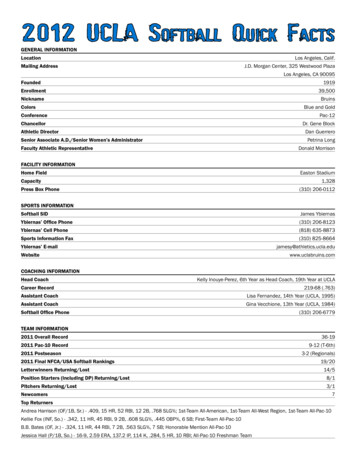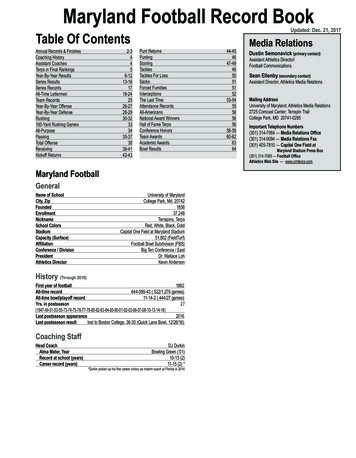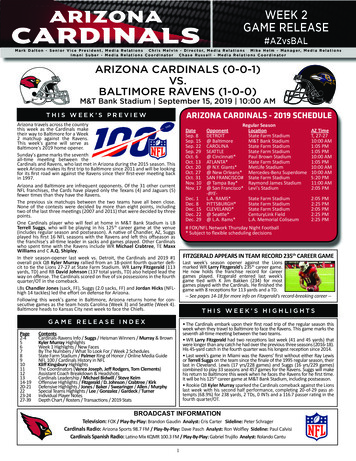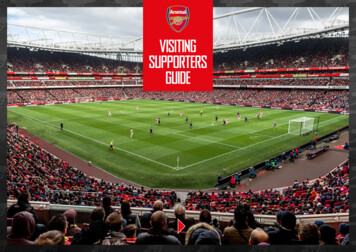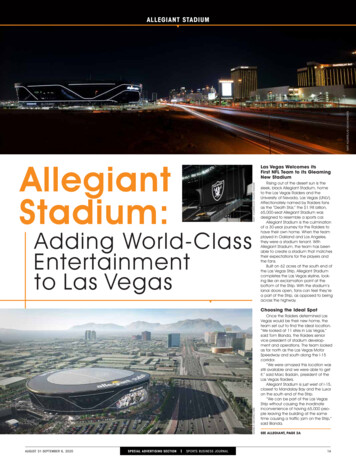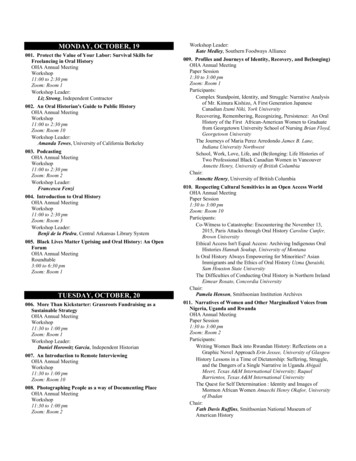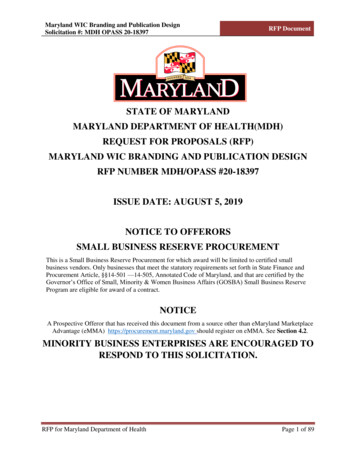
Transcription
Maryland Stadium Authority2002 Annual ReportMaryland Stadium AuthorityThe Warehouse at Camden Yards333 West Camden Street, Suite 500Baltimore, Maryland 21201Telephone 410-333-1560Toll Free 877-MDSTAD (637-8234)Fax 410-333-1888e-mail msa@mdstad.comWeb Site www.mdstad.com
Table of ContentsThe Sports Complex at Camden Yards . . . . . . . . . . . . . . . . . . . . . . . . . .3Project Updates:Completed ProjectsMemorial Stadium . . . . . . . . . . . . . . . . . . . . . . . . . . . . . . . .5Ripken Stadium . . . . . . . . . . . . . . . . . . . . . . . . . . . . . . . . .7Towson University Minnegan Stadium . . . . . . . . . . . . . . . . . .8University of Maryland Baltimore CountyThe “Commons”. . . . . . . . . . . . . . . . . . . . . . . . . . . .10University of Maryland College ParkComcast Center . . . . . . . . . . . . . . . . . . . . . . . . . . . . .11Softball Field . . . . . . . . . . . . . . . . . . . . . . . . . . . . . . .13Current ProjectsHippodrome Performing Arts Center . . . . . . . . . . . . . . . . . .14Veterans’ Memorial . . . . . . . . . . . . . . . . . . . . . . . . . . . . . .16Montgomery County Conference Center . . . . . . . . . . . . . . . .18Camden Station . . . . . . . . . . . . . . . . . . . . . . . . . . . . . . . .19McIntosh Run . . . . . . . . . . . . . . . . . . . . . . . . . . . . . . . . . .20Ocean City Convention Center Study . . . . . . . . . . . . . . . . . .21Special Olympics of Maryland . . . . . . . . . . . . . . . . . . . . . . .21Maryland Stadium Authority Board Members . . . . . . . . . . . . . . . . . . . . .22Maryland Stadium Authority StaffAdministrative. . . . . . . . . . . . . . . . . . . . . . . . . . . . . . . . .25Facilities Management . . . . . . . . . . . . . . . . . . . . . . . . . . . .27Audited Financial Statement . . . . . . . . . . . . . . . . . . . . . . . . . . . . . . . .321
ROBERT L. EHRLICH, JR.GOVERNORRICHARD W. SLOSSONEXECUTIVE DIRECTORTo the Governor and Members of theMaryland General Assembly:The Maryland Stadium Authority is pleased to welcome Governor Ehrlich and the new members of the Maryland General Assembly and present to them our Annual Report for 2002.In its eleventh season, activities at Camden Yards continued to thrive with an assortment ofnon-game events, including the African American Heritage Festival, the Navy-Notre Damefootball game and the State high school championship football games. We are especiallyproud of being named the “most influential sports venue of the past 25 years” in a poll ofmedia and sports-industry executives conducted by the International Sports Summit.The Stadium Authority enjoyed a very successful year with the completion of several projects The Commons at the University of Maryland Baltimore County (UMBC), Ripken Stadium inAberdeen, Minnegan Stadium at Towson University and the Comcast Center and softballfield at the University of Maryland College Park.We currently have several projects in progress and look forward to taking on new challengesin the coming year. It is our hope that we will continue to meet all expectations and, throughour successfully completed projects, enhance the pride in our State and augment the economicdevelopment of Maryland.Sincerely,John Brown, IIIRichard W. SlossonChairmanExecutive Director2
THE SPORTS COMPLEXAT CAMDEN YARDSThe Maryland Stadium Authority enjoyed another successful year within theCamden Yards Sports Complex.The Warehouse continued at full occupancy with fourteen tenants. To ensurethe safety of our tenants and visitors, enhanced perimeter security measures wereput in place, including the strategic placement of large planters and bollards aroundthe Complex. The use of an environmentally friendly electrical vehicle was initiatedfor security patrol. An emergency evacuation drill was held at Ravens Stadium inmid-July to test the response performance, of stadium operations personnel, all ofwhom passed with flying colors.The tenants at Camden Yards again participated in two successful Red Crossblood drives throughout the year.During 2002, the Maryland Stadium Authority began its active supportof Baltimore City’s DASH Program which furnishes low cost transportation for commuters from Camden Yards to areas throughout downtown. This service has theadded benefit of filling the parking lots throughout the Complexduring regular, non-game working hours and adding to the revenuesgenerated at Camden Yards.The facilities at Camden Yards continue to attract a wide variety of eventssponsored by repeat and new customers. Among the major returning events werethe African American Heritage Festival, the Taste of Baltimore, the BaltimoreMarathon, the Race for the Cure and the Turkey Bowl (Calvert Hall v. Poly).Significant events new to Camden Yards in 2002 were the home games of theBayhawks Lacrosse team and the Navy-Notre Dame football game in November. TheDivisions 1A through 4A High School State Football Championship games also wereheld in Ravens Stadium in November.3
More than 180 special events took place within The Warehouse at CamdenYards and in the facilities contained within Oriole Park at Camden Yards. Theseincluded fundraisers, high school and college reunions, job fairs, wedding receptions,corporate functions and meetings, lunches and dinners, a tailgate party and tradeshows. A first-ever Open House was held in July to showcase the opportunities available to host memorable events at the baseball park. This event attracted more than5,000 guests and highlighted the sumptuous variety of food and beverages availablefor on-site events that are guaranteed to please all participants.Ravens Stadium was the site of more than 100 non-game events in additionto the activities sponsored by the football team. These events included fundraisers,luncheons, crab feasts, galas, holiday parties and the Baltimore Marathon.In October, Camden Yards wasthe site of the unveiling of a largerthan-life size statue of NFL footballlegend, Johnny Unitas, at RavensStadium. The team designated thearea at the main stadium entrance as“Unitas Plaza” in tribute to the manwho meant so much to our State andCity.4
PROJECT UPDATESCompleted ProjectsMemorial StadiumProject Director:Site Representative:Edward E. ClineJeffrey K. ProvenzanoDemolition Contractor:Project Budget:Potts & CallahanBaltimore, Maryland 9,850,000Project Summary:Built originally in 1949-1950 and immediately the subject of modificationand expansion, Memorial Stadium became the official home of the National FootballLeague’s Baltimore Colts in 1953 and to the American League’s Baltimore Orioles in1954. Following the move of the Orioles to Camden Yards in 1992, MemorialStadium hosted the Canadian Football League’s Stallions, Minor League Baseball’sBay Sox and the Baltimore Ravens. When the Ravens left for their new home atCamden Yards in 1998, planning for the future of Memorial Stadium began again.Ultimately the City of Baltimore made the decision that Memorial Stadium would bedemolished and the Maryland Stadium Authority was given responsibility for overseeing the demolition which was funded by the Maryland General Assembly.The first steps of the demolition project included environmental remediation andsalvage operations. Then, working closely with representatives of the Babe RuthMuseum, in 2000, MSA began removal of seats and other memorabilia from the sta-5
dium. Items including rest room signs, police call boxes, lockers and ceiling fans weresalvaged. In October, 2000, a public sale and auction was held at Memorial Stadiumaffording Baltimore sports fans an opportunity to obtain a special memento of thegrand old stadium and, at the same time, generating revenues tooffset demolition costs.The time capsule placed within the structure of Memorial Stadium was recoveredand opened in January, 2002, revealing a host of memorabilia from the stadium’sdedication. Demolition of Memorial Stadium began in February, 2001 and was completed in the Spring of 2002.6
Ripken StadiumProject Director:Site Representative:Gary A. McGuiganJeffrey K. ProvenzanoArchitect:General Contractor:Design ExchangeBaltimore Contractors, Inc.Construction Manager:Project Budget:Heery International 18 MillionThe Maryland Stadium Authority worked with the City of Aberdeen, HarfordCounty and private investors, including Baltimore baseball legends Cal and allstadium. Visible from Interstate 95, the facility has 2,000 adjacent parking spacesand is located on 30 acres in Aberdeen, Maryland next to the planned RipkenAcademy. The Academy will include six separate fields, each a replica of a past orpresent Major League Baseball park, i.e., Oriole Park at Camden Yards, Fenway Park,Wrigley Field, Memorial Stadium and Ebbet’s Field.Ripken Stadium celebrated its official opening on June 18, 2002 and the inaugural season was a huge success with the Ironbirds playing to sold out crowds nightafter night.7
Towson UniversityMinnegan StadiumProject Director:Architect:Kim I. McCallaCho, Benn & Holback /Ellerbe BecketConstruction Manager:Project Budget:Barton Malow Company/Essex 31.7 MillionCompleted in September, 2002, the project to expand and renovate MinneganStadium enables it to serve as a sports and academic complex for Towson University.As a result of the entrance of the University into the Patriot League, stadium seating was increased from 4,500 to 11,000 and specific enhancements made. The grassfield was replaced with artificial turf and the lighting modernized and moved awayfrom fan sight lines.Existing press facilities were demolished and replaced with a new pressbox which includes radio, scoreboard and coaches booths; a multi-purposesuite was incorporated into the stadium; concession operations were increased to36 point-of-sale locations; rest room facilities were increased and thestadium brought into compliance with the Americans with Disabilities Act.The field house, to be completed in March, 2003, now encompassestwo visitors’ locker rooms, (divisible into four) and locker rooms for gameofficials. New locker room facilities were incorporated for the football, fieldhockey, men’s and women’s lacrosse teams with training facilities andequipment rooms now having direct access to the field. Space designed forclassrooms and a learning center for athletes also was made a part of thestadium facility.8
The improvements to this facility not only enhance the accommodations forTowson University’s teams and sports fans but also provide the area with afacility that can be utilized by the surrounding community.Phase II of the construction, which included building the North Sideseating, restrooms, concession stands, ticket areas, a promenade to connectthe north and south sides of the stadium and work on the associated utilitiesand infrastructure was completed in 2001. Phase III, which involveddemolition of the original stadium and replacing it with new seating,restrooms and concession stands, began in Summer, 2001 and wascompleted in 2002.The newly enhanced stadium complex has become an integral part ofcampus life for Towson University and the surrounding neighborhoods.9
University of MarylandBaltimore County“The Commons”Project Director:Architect:Gary A. McGuiganDesign Collective, Inc./Perry Dean Rogers & PartnersConstruction Manager:Project BudgetBarton Malow / Essex 35.2 MillionThis project, funded by the University of Maryland, Baltimore County, involvedthe design and construction of “University Commons,” a centerpiece campus facility.The “Commons,” a 150,000 square foot structure includes meeting rooms, food andretail outlets and a book store. Also incorporated into the building is a recreationarea, facilities for the student government association, a student-run night club, abank and a copying center. “The Commons” opened its doors to students on January28, 2002 and received “rave reviews” from the students and faculty alike.“The Commons” has been recognized by the American Institute of Architects(AIA) for its unique design and also by various associations with awards for craftsmanship.10
University of MarylandCollege ParkComcast CenterProject Director:Architect:Kim I. McCallaEllerbe Becket /Design CollectiveConstruction ManagerProject BudgetGilbane Building Company /Smoot, JV 126.8 MillionIn October, 2002, the Maryland Stadium Authority, working withrepresentatives of the University of Maryland, College Park, successfully completedon schedule the design and construction of the new Comcast Center located on theNorth Field area of the University’s campus, adjacent to the intramural athleticfields.The Comcast Center includes a 17,900 seat basketball facility and accommodates the activities formerly housed in Cole Field House. The “feel” of Cole FieldHouse was retained with 2,500 of the 4,000 students being seated surrounding thecourt and the remainder located in the end zone. The view into the seating bowlfrom the main concourse also is reminiscent of Cole Field House.The Comcast Center features a 7,000 square foot Academic Supportand Career Development Center, a student activity center, accommodates facilitiesfor 25 different sports and incorporates a well-equipped training facility. The projectincluded the arena, parking, utilities and other associated activities.11
Special features of the arena include: Removable Lower Seats Training Rooms Weight Training Rooms Increased Concessions & Rest Rooms Press Area Compliance with ADA Team Store Practice Courts, Wrestling Gym “Walk and Hall of Fame” Athletic Administration Offices “Heritage Hall”12
University of MarylandCollege ParkSoftball FieldProject Manager:Architect:Kim I. McCallaEllerbe Becket /Design Collective, Inc.Construction ManagerProject Budget:Gilbane Building Company /Smoot, JV 4.1 MillionThe 1,000 seat softball stadium incorporates a press box, rest roomsand a concession stand. Completed in March, 2002, the facility was ready for theUniversity’s spring season.13
Current ProjectsHippodrome Performing Arts CenterProject Director:Architect:Robert BorasHardy Holzman Pfeiffer Associates, LLPNew York, New York /Murphy & DittenhaferBaltimore, MarylandConstruction Manager:Project Budget:The Whiting Turner ContractingCompanyEstimated at 63 MillionLocated on North Eutaw Street, the HippodromeTheater, built as a Vaudeville House in 1914, is one of thelast remaining historic Thomas Lamb theaters. The renovated Hippodrome theater with 2,250 seats, will serve asthe anchor for Baltimore City’s Westside Renaissance.The Maryland Stadium Authority is overseeing thedesign and construction of the renovated Hippodrome,working with representatives of the Baltimore Center forthe Performing Arts and Clear Channel Entertainment, thetheater operator. The Hippodrome project is considered tobe the catalyst for the renewal of eighteen blocks associated with Baltimore’s Westside.In addition to the Hippodrome, the buildings adjacent to the theater are essential to developing the performing arts center complex which will include a new stagehouse, lobbies, retail box office, administrative offices,loading dock and flexible multi-purpose spaces. These properties include buildingswhich formerly housed the Eutaw Savings Bank, the Western Savings Bank and theEutaw Building.During 2002, the Stadium Authority completed the complicatedfinancing structure, a pre-condition to the sale of bonds. Bonds for the HippodromePerforming Arts Center were then issued in the amount of 20,250,000. The financing for this project resulted in the establishment by MSA of a for-profit subsidiary,necessary to obtain federal historic tax credits.14
In addition to the MSA bond and tax credit funds, the project is being financedby a contribution from the City of Baltimore, a endowment from Baltimore County,an investment from Clear Channel and a bank loan secured by private donors. Inorder to move ahead, MSA’s bond financing was increased in 2002 through legislation intended to replace funds that otherwise would have been generated by Statetax credits. The financing package was an extraordinary example of a successfulpublic/private partnership.Contracts associated with this project include: relocation of siteutilities, excavation, demolition, foundations, structural steel, cast-in-place concrete,masonry, curtain wall and electrical and mechanical systems, exterior and interiorhistoric restoration and interior finishes.For the first time ever, performances of large touring Broadway shows will bepossible at the renovated Hippodrome Performing Arts Center scheduled for completion in February, 2004.In October, 2002, a special event was held on the Hippodrome site. Dancersfrom “42nd Street” were on hand to kick-off the ceremony.15
Veterans’ MemorialProject Director:Site Representative:Edward E. ClineJeffrey K. ProvenzanoArchitect:Contractor:CS&D ArchitectsBaltimore, MarylandWhiting TurnerContracting CompanyBaltimore, MarylandEstimated Budget: 775,000The Maryland Stadium Authority is overseeing construction of the veterans’memorial at the Sports Complex at Camden Yards. The language on the newmemorial incorporates most of the essential wording from the memorial formerlylocated on Memorial Stadium on 33rd Street but is updated to include veterans ofall of our Nation’s wars.The creation of this memorial will enable more than 4 million people each yearto personally see this tribute to our veterans when they visit Camden Yards for agame, special event or as a destination itself. This ground-level memorial will affordthe opportunity for visitors to pause and reflect on the valiant effort and sacrificemade by so many of our brave soldiers to preserve America’s freedom.16
Construction of the new memorial began in September, 2002. The ceremonialgroundbreaking was held on Veterans’ Day, November 11th, 2002. Completion of thememorial is scheduled for Spring, 2003 with a special dedication being held onMemorial Day, 2003.17
Montgomery County Conference CenterProject Director:Architect:Gary A. McGuiganRTKLWashington, D. C.Developer:Estimated Budget:Quadrangle Development Corporation 66 MillionContractor:Hitt Contracting, Inc.The Maryland Stadium Authority is responsible for oversight of design andconstruction of the Montgomery County Conference Center. The cost of the Centerwill be financed through funding from Montgomery County and the MarylandStadium Authority. The Conference Center will be connected with an adjacentMarriott hotel being developed by Quadrangle Development Corporation. TheStadium Authority is authorized to issue up to 23.1 million in revenue bonds whichare expected to be sold in January, 2003.On December 18, 2002, the Stadium Authority received approval to issue thebonds and to enter into a construction contract with Hitt Contracting, Inc.Construction is expected to begin in February, 2003.18
Camden StationProject Director:Construction Manager:Gary A. McGuiganWhiting Turner Contracting CompanyEstimated Budget (Core & Shell) 8.5 MillionThe Maryland Stadium Authority is overseeing essential repairs to this 45,000square feet historic building at the gateway to the Camden Yards Sports Complex.The station, unused since the 1980’s, is in serious danger of suffering substantialstructural damage unless immediate steps are taken to preserve the building’sintegrity.It is anticipated that the basement and first floor of the Station ultimately willbe occupied by an expansion of the Babe Ruth Museum. The Museum would utilizethis space for a 23,000 square foot sports museum that would include exhibits featuring the Orioles, Cal Ripken, Johnny Unitas, the Maryland Terrapins and otherexciting themes. The balance of the Station’s space would be leased to a commercial tenant.19
McIntosh RunArchitect:Gary Player DesignsProject Director:Estimated Budget:Robert Boras 15.3 MillionLocated within the boundaries of Leonardtownin St. Mary’s County, Maryland, McIntosh Run willshowcase a Gary Player signature golf course. It isanticipated that this project will stimulate the development of 600 new residential units as well as ahotel-conference center and marina on the shoresof Breton Bay. This economic development projectwill incorporate careful planning and design withenvironmental sensitivity and include manyelements of the Smart Growth Policy. McIntosh Runwill be built utilizing the existing infrastructure andis expected to make a significant contribution to theeconomic growth of Leonardtown.A groundbreaking ceremony for the golf coursewas held in late June, 2002 and included representativesof the State of Maryland, St. Mary’s County, the Town ofLeonardtown, the Maryland Stadium Authority and GaryPlayer himself.The Maryland Stadium Authority willoversee the development and construction of the golf course and is workingclosely with the Maryland Department ofBusiness and Economic Development(DBED), the Maryland Department ofNatural Resources (DNR) and theMarylandEconomicDevelopmentCorporation (MEDCO) which is providingthe funding for this project.20
Ocean City Convention Center StudyProject Director:Estimated Budget:Gary A. McGuiganTBDContractor:Heery InternationalBaltimore, MarylandBecause of the Stadium Authority’s successful completion of the 1996 expansion of the Ocean City Convention Center, the Town of Ocean City requested that weoversee a study to determine the feasibility of expanding the Ocean City ConventionCenter. The study for estimating and architectural services includes expansion of theexhibit hall by 30,000 square feet and adding approximately 12 meeting roomsoffering views of the Bay. The study was completed in late December, 2002.Special Olympics of MarylandProject Director:Estimated Budget:Gary A. McGuigan 24 - 28 MillionArchitect:CS&D ArchitectsBaltimore, MarylandThe Maryland Stadium Authority is working with Special Olympics of Marylandon a new facility building. The headquarters building will include offices for SpecialOlympics and a multi-purpose gym, two basketball courts. Also included in this project will be a soccer field, an eight-lane track, softball field and tennis courts. Thefacility primarily will be utilized for the training of coaches involved in the SpecialOlympics program but will be available for use by the public.Special Olympics of Maryland and the Maryland Stadium Authority are exploring the possible location and timing of the project.21
Maryland Stadium Authority BoardJohn Brown, IIIChairmanJohn Brown, III was appointed Chairman of the Maryland StadiumAuthority on January 1, 1999 and has served as a member of theAuthority since March, 1995. Mr. Brown is President of M.B.K.Enterprises, Inc. (R. J. Bentley’s Restaurant) and Managing Partner ofthe College Park Professional Center. He also serves as President of theDowntown College Park Management Authority and is on the Board ofDirectors of the Restaurant Association of Maryland, serving asGovernment Relations Committee Chairman. Actively involved in numerous organizations affiliated with the University of Maryland, Mr. Brown serves as a member of theInner Circle of the Michael D. Dingman Center for Entrepreneurship; the MarylandBusiness School Alumni Chapter Board of Directors; the University of Maryland AlumniAssociation, Inc. Board of Governors and is a Past President of the University ofMaryland Terrapin Club. Mr. Brown is a member of the Board of the University ofMaryland Medical Systems. Mr. Brown received a B.S. Degree from the College ofBusiness and Management of the University of Maryland. He was recognized by theRobert H. Smith School of Business as one of its outstanding alumni in 1998.Richard W. SlossonExecutive DirectorRichard “Rick” Slosson was named Executive Director of the MarylandStadium Authority effective March 1, 2000. An engineer with more than20 years’ experience in the construction, development and land useindustry, he has worked on projects in 33 States, two CanadianProvinces, Europe and the Pacific Rim.Prior to joining the Stadium Authority, Mr. Slosson served as ExecutiveVice President of Sunrise Development, Inc., a wholly owned subsidiary of SunriseAssisted Living. In that capacity he was responsible for all phases of feasibility studies,site acquisition, project planning and design, contract negotiations and construction ofall projects.Before joining Sunrise in 1996, Mr. Slosson was employed by The Evans Company asVice President of Construction from 1989 to 1996; as Contracts Manager / SeniorProject Manager for Omni Construction from 1984 to 1989 and as a Project Engineer /Project Manager for the Whiting Turner contracting company from 1979 to 1984. Mr.Slosson was involved in many projects in the Baltimore Metropolitan Area including theNational Aquarium, Harbor Place, the Baltimore Zoo, General Motors Assembly Plant,the Back River Waste Water Treatment Plant and The Annapolis Hotel.A graduate of the University of Virginia with a Bachelor of Science Degree inEngineering, Mr. Slosson is married to Marylee and the father of two children, Scott andMegan.22
F. Vernon BoozerF. Vernon Boozer was appointed a member of the Maryland StadiumAuthority on July 1, 1999. Mr. Boozer served as a member of theMaryland General Assembly for twenty-eight (28) years, first as aDelegate (1971 - 1979) and then as a member of the Maryland StateSenate (1981 - 1999). During his tenure in the Maryland Legislature,Mr. Boozer served as Minority Leader and on numerous committeesincluding the Senate Budget & Taxation Committee, the RulesCommittee, Legislative Policy Committee, Joint Management ofPublic Funds and Finance Committee. Born in Norfolk, Virginia, Mr. Boozer receivedhis A.B. Degree from Duke University and his J.D. from the University of MarylandSchool of Law. Married with four children, Mr. Boozer is a partner in the law firm ofCovahey & Boozer in Towson, Maryland.Earl U. Bravo, Sr.Earl U. Bravo, Sr. was appointed to the Maryland Stadium Authorityin July, 2001 for a four-year term, Mr. Bravo serves as ChiefOperating Officer of The Chapman Companies, a publicly-traded,minority-controlled brokerage firm in Baltimore City. Before assuming his current responsibilities, Mr. Chapman was President of TheChapman Capital Management subsidiary, managing all planning,marketing, administration, regulatory filings and portfolio management for the firm. Prior to joining the Chapman Company, Mr. Bravowas Vice President in the Retail Finance Division of the Maryland NationalCorporation. A member of the Greater Baltimore Committee’s Public PolicyCommittee, Mr. Bravo is on the Advisory Board of the Urban Financial ServicesCoalition (formerly the Maryland Association of Urban Bankers) where he formerlyserved as Association President. Mr. Bravo earned a B.A. in economics from HowardUniversity and received his M.B.A. from the University of Maryland, College Park. Mr.Bravo lives in Baltimore City.Michael R. EnrightMichael R. Enright was named as a member of the Maryland StadiumAuthority on April 10, 2000 representing the City of Baltimore. Mr.Enright serves as Baltimore’s First Deputy Mayor. Prior to joining theMayor’s staff, Mr. Enright was Legislative Director for United StatesCongressman Benjamin Cardin where he oversaw management ofthe legislative staff and the day-to-day legislative activities forRepresentative Cardin. From 1991 until 1998, Mr. Enright served asExecutive Assistant to Maryland Attorney General J. Joseph Curran.In this role, he directed the communications operation and served as speech writerand spokesperson for the Attorney General. Before joining General Curran’s staff, Mr.Enright worked as a newspaper reporter and freelanced for the Baltimore Sun and awire service syndicated by the New York Times. Born in Washington, D. C., Mr.Enright, received his Bachelor of Arts Degree in English (with honors) from TulaneUniversity in New Orleans, Louisiana and his Master’s Degree in PublicAdministration from Harvard University’s Kennedy School of Government.23
Dennis C. MurphyDennis C. Murphy became a member of the Stadium Authority onAugust 1, 1997. He serves as President of Murphy and HoganCommercial Real Estate Services in Annapolis. A ProfessionalCertified Economic Developer, Mr. Murphy has served as President ofthe Maryland Industrial Development Association, a member of theBoard of Directors of the American Economic Development Counciland a member of the Prince George’s County Private IndustryCouncil. Mr. Murphy also served as President and Chief ExecutiveOfficer of the Prince George’s County Economic Development Corporation. AWashington area native, Mr. Murphy attended secondary school and college in PrinceGeorge’s County and served in the U.S. Marine Corps.Robin O. OegerleRobin O. Oegerle was appointed to the Maryland Stadium Authorityon January 1, 1999. She serves as Director of Marketing and mediaspokesperson for Ferris, Baker Watts, Inc. in Baltimore as well asfunctioning as Coordinator of the Ferris Baker Watts Foundation. Ms.Oegerle served as Treasurer for Governor Parris N. Glendening’s election campaign; as Vice Chairman for Maryland Public Television; asTreasurer to the Committee to Re-Elect Sitting Judges in PrinceGeorge’s County and as Chairman, Vice Chairman and Treasurer ofthe Parking Authority of Prince George’s County. Ms. Oegerle received a B.A. Degreefrom the University of Florida and a Masters Degree from the University ofMassachusetts.James A. SolteszJames A. Soltesz was confirmed as a member of the MarylandStadium Authority on March 23, 2001. Mr. Soltesz is President, CEOand Past Executive Vice President of Loiederman Soltesz Associates.Since joining the firm in 1990, Mr. Soltesz has been responsible forthe operation of four corporate offices and serves as Chairman of theBusiness Development Committee and Principal of the firm’s subsidiary, Property Development Consulting Services, which offersadvisory services to lending institutions, private investors and develop
The Commons at the University of Maryland Baltimore County (UMBC), Ripken Stadium in Aberdeen, Minnegan Stadium at Towson University and the Comcast Center and softball field at the University of Maryland College Park. We currently have several projects in progress and look forward to taking on new challenges in the coming year.

